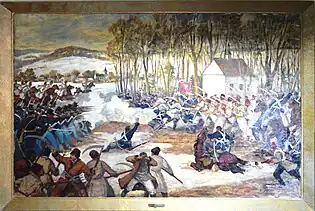| Battle of Gdów | |||||
|---|---|---|---|---|---|
| Part of Kraków Uprising | |||||
 War Cemetery in Gdów | |||||
| |||||
| Belligerents | |||||
|
|
| ||||
| Commanders and leaders | |||||
|
| Ludwig von Benedek | ||||
| Strength | |||||
|
380 insurgents
|
482 soldiers
| ||||
| Casualties and losses | |||||
|
154 killed 20 prisoners |
2 Austrian cavalrymen taken prisoner for a short time[1] One horse wounded in leg[2] | ||||
The Battle of Gdow (Polish language: Bitwa pod Gdowem) took place on February 26, 1846 near Gdow, Free City of Krakow. It was the only battle of the Krakow Uprising: a 380-strong rebel unit commanded by Jakub Suchorzewski was defeated by a 480-strong Austrian Army detachment under Ludwig von Benedek. The Austrians were supported by some 500 local peasants (see Galician slaughter). Rebel losses were estimated at 154 killed in action, while Austrian losses were negligible.

Background
After the Krakow Uprising had begun, an Austrian detachment under Colonel Ludwig von Benedek left Tarnów, heading towards Krakow. Von Benedek had almost 500 men, including 330 infantry and 150 cavalry. Along the way, his unit was reinforced by local peasants from several villages, such as Marszowice, Nieznanowice and Pierzchow. The peasants were promised a hundredweight of salt and 5 Cracow zlotys for each captured rebel.
Battle
Meanwhile, a rebel unit of 380 men (mostly residents of Cracow and local szlachta) under Colonel Jakub Suchorzewski concentrated in Lazany, 8 km southeast of Wieliczka. In the morning of the February 26, insurgents reached Gdów and they scattered around the town seeking food. Bolesław Limanowski wrote that Suchorzewski didn't expect the Austrians to trace him so quickly and that is why he allowed his soldiers to rest. Whereas, Suchorzewski himself headed to a local manor for a meal, so that he presumably even wasn't in Gdów during the battle.
The Austrian troops at first met a few insurgents who were standing on guard over the bridge on Raba. They started shooting to each other but Poles retreated quickly to the centre of Gdów, where they warned the rest of insurgents about the approaching enemy. Those, in most cases drunk, chaotically escaped from inn and houses, crowding in the town centre. Meanwhile von Benedek launched a flanking manoeuvre and surrounded a unit of kosynierzy near the cemetery's wall. They were then attacked by furious peasants and only few were saved by the Austrians who intervened too late.[3] Suchorzewski himself fled to Dobczyce, taking with him rebel money.
Altogether, rebel losses were 154: all were buried in three pits, dug at the cemetery. Survivors fled to Krakow, while on the next day the Austrians entered Wieliczka.
References
- ↑ Kronika rewolucyi krakowskiej w roku 1846. Nakł. Autora. 1898.
- ↑ Wasze wpisy O Gdowie, który nigdy nie będzie miastem.
- ↑ "Rzeź i ranny koń – czyli jedyna bitwa powstania krakowskiego" (in Polish). twojahistoria.pl. Retrieved 6 June 2020.
Sources
- Mała Encyklopedia Wojskowa, 1967, Wydanie I
- Jerzy Zdrada, Historia Polski 1795-1914, Warszawa 2007
- Julius Kreipner, Geschichte des K.und K.Infanterie-Regimentes Nr. 34 für immerwährende Zeiten Wilhelm I. Deutscher Kaiser und König von Preussen, 1733-1900, Kosice 1900